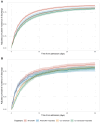Addition of Macrolide Antibiotics for Hospital Treatment of Community-Acquired Pneumonia
- PMID: 39718980
- PMCID: PMC11998547
- DOI: 10.1093/infdis/jiae639
Addition of Macrolide Antibiotics for Hospital Treatment of Community-Acquired Pneumonia
Abstract
Background: Guidelines recommend combining macrolides with β-lactam antibiotics for moderate-to-high severity community-acquired pneumonia (CAP); however, macrolides pose risks of adverse events and anti-microbial resistance.
Methods: We analyzed electronic health data from 8872 adults hospitalized with CAP in Oxfordshire, UK (2016-2024), initially treated with amoxicillin or co-amoxiclav. Using inverse probability treatment weighting, we examined the effects of adjunctive macrolides on 30-day all-cause mortality, time to hospital discharge, and changes in Sequential Organ Failure Assessment (SOFA) score.
Results: There was no evidence of an association between adjunctive macrolides and 30-day mortality (marginal odds ratio 1.05 [95% CI 0.75-1.47] for amoxicillin with vs. without macrolide; 1.12 [0.93-1.34] for co-amoxiclav with vs. without macrolide); and no evidence of a difference in time to discharge (restricted mean days lost +1.76 days [-1.66, +5.19] for amoxicillin, +0.44 days [-1.63, +2.51] for co-amoxiclav). Macrolide use was not associated with SOFA score decreases. Results were consistent across severity sub-groups and sensitivity analyses with missing covariates imputed.
Conclusions: At a population level, the addition of macrolides was not associated with improved clinical outcomes for patients with CAP. The potential benefits of additional macrolides should be weighed against the risks of adverse effects and anti-microbial resistance.
Keywords: antimicrobial resistance; community-acquired pneumonia; macrolide; mortality; β-lactam.
© The Author(s) 2024. Published by Oxford University Press on behalf of Infectious Diseases Society of America.
Conflict of interest statement
Potential conflicts of interest . The authors: No reported conflicts of interest. All authors have submitted the ICMJE Form for Disclosure of Potential Conflicts of Interest. Conflicts that the editors consider relevant to the content of the manuscript have been disclosed.
Figures

References
-
- National Institute for Health and Care Excellence . Recommendations. Pneumonia (community-acquired): antimicrobial prescribing. 2019. https://www.nice.org.uk/guidance/ng138/chapter/Recommendations. Accessed 27 August 2024.
-
- Lim WS, Baudouin SV, George RC, et al. . BTS guidelines for the management of community acquired pneumonia in adults: update 2009. Thorax 2009; 64:iii1–55. - PubMed
-
- Martin-Loeches I, Torres A, Nagavci B, et al. . ERS/ESICM/ESCMID/ALAT guidelines for the management of severe community-acquired pneumonia. Eur Respir J 2023; 61:2200735. - PubMed
-
- Reijnders TDY, Saris A, Schultz MJ, van der Poll T. Immunomodulation by macrolides: therapeutic potential for critical care. Lancet Respir Med 2020; 8:619–30. - PubMed
MeSH terms
Substances
LinkOut - more resources
Full Text Sources
Medical
Miscellaneous

